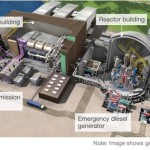 In safety-critical organisations such as civil-nuclear and aerospace, managing uncertainty is of particular importance as the consequences of failure can be potentially catastrophic. The challenge facing project managers in these complex, socio-technical environments is how to better understand the sources of project uncertainty and how to navigate a path through them in pursuit of successful project outcomes.
In safety-critical organisations such as civil-nuclear and aerospace, managing uncertainty is of particular importance as the consequences of failure can be potentially catastrophic. The challenge facing project managers in these complex, socio-technical environments is how to better understand the sources of project uncertainty and how to navigate a path through them in pursuit of successful project outcomes.
My Exploratory Study, just published in the International Journal of Project Management (Feb 2015), drew on interviews with project management practitioners from several large-scale projects in civil-nuclear and aerospace companies in the United Kingdom to identify four conceptual approaches that may be adopted by project managers to manage project uncertainty.
The first conceptual approach was a structural one: respondents spoke in terms of platforms of certainty and pools of uncertainty, underpinning processes, stakes in the ground and boundaries. Respondents navigated uncertainty by enacting the various project processes, in particular, risk management, scope definition and gated review processes. These processes provided a structure to identify uncertainties and a means of managing them. Steering reviews and gated decision points especially were seen as essential in documenting uncertainties, and converting assumptions to knowledge to ensure the project could be delivered. The risk management process was a key process in managing uncertainty. In the presence of high levels of uncertainty and the imperative to deliver safety-critical projects, the familiar processes and routines of project management were mobilised as bridges to connect the platforms of certainty and gradually shrink the remaining pools of uncertainty.
Secondly, respondents conceptualised their approach to managing uncertainty in behavioural terms; as an attitude encompassing flexibility, optimism, conscious decision making and being constantly attuned to the presence of uncertainty. Respondents that thrived in this environment acknowledged that uncertainty could not be eliminated; only reduced through pro-active questioning of assumptions and pragmatic decision-making. Several respondents stressed the importance of being able to remain flexible; maintaining focus on the project outcomes whilst operating amid high levels of uncertainty. It may simply not be possible to finalise project schedules, or provide accurate estimates if timescales are long and scopes vague. Managing projects in this way can stress the prevailing organisational culture, particularly if it is risk adverse, with project managers finding themselves at the nexus of two of the key tensions in safety-critical industries: firstly, the tension between an organisational culture of command and control and a project management need for a culture more akin to doubt and discovery and secondly, between regulator and licensee views on safety requirements . Balancing these competing tensions is likely to require tough, politically adept project managers with excellent soft skills .
Thirdly, respondents viewed uncertainty as a relational construct – stressing the importance of communicating uncertainty to sponsors and other key stakeholders such as clients, regulators, or members of the project team. Frequent dialogue with industry regulators was important to ensure that the emerging project design would not spring any surprises on the regulator. Several respondents reported the need to make uncertainty visible, constantly communicating it, rather than hiding or ignoring it. Obtaining “buy-in” for the real level of uncertainty on a particular project was seen as essential to managing the impact of uncertainty in safety-critical projects, although achieving this was not without challenge and required excellent communication and influencing skills to maintain senior management confidence in the project and its inherent uncertainties.
The fourth and final conceptual approach was an orientating one: respondents used navigational metaphors such as “markers in the sand”, “the fog of uncertainty”, “rear view mirror” and “looking ahead” to conceptualise uncertainty. Respondents orientated themselves within the project uncertainty through the use of a range of structured techniques such as brainstorming, horizon scanning and sensitivity analysis. Brainstorming was carried out both informally through ad-hoc conversations and formally by assembling relevant multidisciplinary experts. Heuristics from past projects were used both by individual respondents and project teams to help conceptualise new projects at the scoping phase, although interviewees acknowledged that in safety-critical industries where individuals generally hold a surfeit of tacit knowledge, both these techniques can lead to bias and complacency, and an inability to spot those black swan events, or bolts from the blue that have the potential to derail a project. Conversely lessons-learnt logs were perceived as an ineffective source of knowledge on project uncertainty, primarily due to problems on indexing and accessing the relevant information. Respondents were more likely to seek their colleagues’ opinions and knowledge about past projects, viewing this as a more efficient and contextually rich means of orientating themselves.
Other techniques used by respondents were the use of small scale trials to drive out larger uncertainties in projects . Here the trials were used to reduce knowledge gaps, allowing the project team to learn and subsequently adapt their approach to project delivery.
Project contingency (on cost, time and project scope) was viewed by several as an essential tool in confronting uncertainty, as it provides the project manager with the flexibility to adapt to the emergence of new information without necessarily putting the project delivery at risk.
The boundaries between the four approaches – structural, behavioural, relational and orientating are not fixed but overlap, with many statements made by respondents embracing more than one approach to the management of uncertainty. Nevertheless, the way in which respondents articulated their approach to the management of project uncertainty gives an important insight into their internal mental models of uncertainty and a window into the connection between these internal conceptualisations of uncertainty and external actions taken to deal with it.
For more details on the study methodology please download the full paper here (institutional log in required)

Nice work. Liked your IJPM 2015 article.